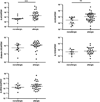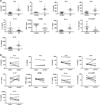A striking local esophageal cytokine expression profile in eosinophilic esophagitis
- PMID: 21211656
- PMCID: PMC3027004
- DOI: 10.1016/j.jaci.2010.10.039
A striking local esophageal cytokine expression profile in eosinophilic esophagitis
Abstract
Background: Eosinophilic esophagitis (EE) is an emerging worldwide disease that mimics gastroesophageal reflux disease.
Objective: Early studies have suggested that esophageal eosinophilia occurs in association with T(H)2 allergic responses, yet the local and systemic expression of relevant cytokines has not been well characterized.
Methods: A human inflammatory cytokine and receptor PCR array containing 84 genes followed by PCR validation and multiplex arrays were used to quantify cytokine mRNA in esophageal biopsies and blood samples.
Results: Esophageal transcripts of numerous chemokines (eg, chemokine [C-C motif] ligand [CCL] 1, CCL1, CCL23, CCL26 [eotaxin-3], chemokine [C-X-C motif] ligand [CXCL] 1, and CXCL2), cytokines (eg, IL13 and ATP-binding cassette, subfamily F, member 1), and cytokine receptors (eg, IL5 receptor, alpha) were induced at least 4-fold in individuals with EE. Analysis of esophageal biopsies (n = 288) revealed that eotaxin-3 mRNA level alone had 89% sensitivity for distinguishing individuals with and without EE. The presence of allergy was associated with significantly increased esophageal expression of IL4 and IL5 mRNA in patients with active EE. We identified 8 cytokines (IL-4, IL-13, IL-5, IL-6, IL-12p70, CD40 ligand, IL-1α, and IL-17) whose blood levels retrospectively distinguished 12 patients without EE from 13 patients with EE with 100% specificity and 100% sensitivity. When applied to a blind, prospectively recruited group of 36 patients, the cytokine panel scoring system had a 79% positive predictive value, 68% negative predictive value, 61% sensitivity, and 83% specificity for identifying EE.
Conclusion: Evidence is presented that IL13 and IL5 associate with eosinophil and eotaxin-3 levels, indicating the key role of adaptive T(H)2 immunity in regulating eotaxin-3-driven esophageal eosinophilia in the absence of a consistent systemic change in cytokines.
Copyright © 2010 American Academy of Allergy, Asthma & Immunology. Published by Mosby, Inc. All rights reserved.
Figures





References
-
- Furuta GT, Liacouras CA, Collins MH, Gupta SK, Justinich C, Putnam PE, et al. Eosinophilic esophagitis in children and adults: a systematic review and consensus recommendations for diagnosis and treatment. Gastroenterology. 2007;133(4):1342–1363. - PubMed
-
- Assa'ad AH, Putnam PE, Collins MH, Akers RM, Jameson SC, Kirby CL, et al. Pediatric patients with eosinophilic esophagitis: an 8-year follow-up. J Allergy Clin Immunol. 2007;119(3):731–738. - PubMed
-
- Straumann A, Simon HU. Eosinophilic esophagitis: escalating epidemiology? J Allergy Clin Immunol. 2005;115(2):418–419. - PubMed
-
- Liacouras CA, Bonis P, Putnam PE, Straumann A, Ruchelli E, Gupta SK, et al. Summary of the First International Gastrointestinal Eosinophil Research Symposium. J Pediatr Gastroenterol Nutr. 2007;45(3):370–391. - PubMed
-
- Blanchard C, Wang N, Rothenberg ME. Eosinophilic esophagitis: pathogenesis, genetics, and therapy. J Allergy Clin Immunol. 2006;118(5):1054–1059. - PubMed
Publication types
MeSH terms
Substances
Grants and funding
- DK076893/DK/NIDDK NIH HHS/United States
- AI070235/AI/NIAID NIH HHS/United States
- R01 AI083450/AI/NIAID NIH HHS/United States
- P30 DK0789392/DK/NIDDK NIH HHS/United States
- Z01 NR000014/ImNIH/Intramural NIH HHS/United States
- R01 AI045898/AI/NIAID NIH HHS/United States
- U19 AI070235/AI/NIAID NIH HHS/United States
- R01 DK076893/DK/NIDDK NIH HHS/United States
- R21 AI079874/AI/NIAID NIH HHS/United States
- P30 DK078392/DK/NIDDK NIH HHS/United States
- R37 AI045898/AI/NIAID NIH HHS/United States
- AI045898/AI/NIAID NIH HHS/United States
LinkOut - more resources
Full Text Sources
Other Literature Sources
Medical
Research Materials

